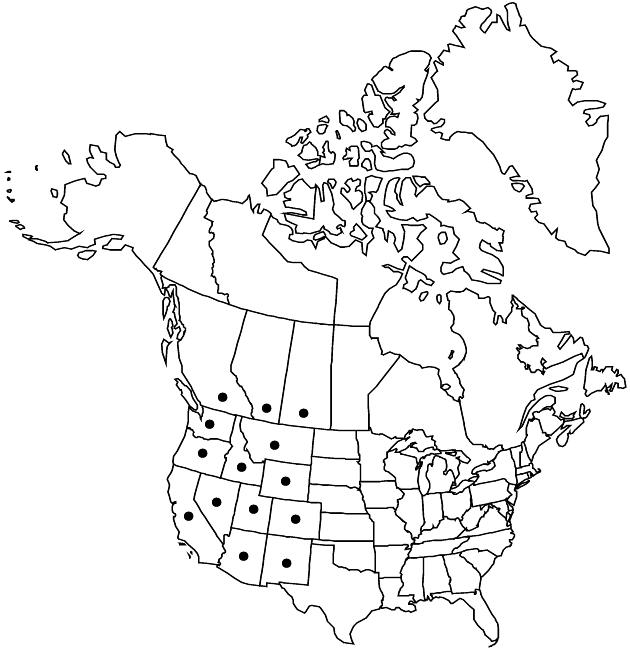Difference between revisions of "Crepis intermedia"
in A. Gray et al., Syn. Fl. N. Amer. 1(2): 432. 1884.
FNA>Volume Importer |
FNA>Volume Importer |
||
| Line 27: | Line 27: | ||
|elevation=800–3900 m | |elevation=800–3900 m | ||
|distribution=Alta.;B.C.;Sask.;Ariz.;Calif.;Colo.;Idaho;Mont.;Nev.;N.Mex.;Oreg.;Utah;Wash.;Wyo. | |distribution=Alta.;B.C.;Sask.;Ariz.;Calif.;Colo.;Idaho;Mont.;Nev.;N.Mex.;Oreg.;Utah;Wash.;Wyo. | ||
| − | |discussion=<p>Crepis intermedia is a somewhat unnatural group of polyploid apomicts that combines the features of multiple species, including C. acuminata, C. pleurocarpa, C. modocensis, and C. atribarba (E. B. Babcock 1947). The plants are usually over 25 cm, with leaves deeply pinnately lobed (gray-tomentose, cleft about halfway to midribs), with acuminate apices, and more or less flat-topped arrays of heads. The leaves vary greatly in size and lobing and are always gray-tomentose. The number of heads per plant is usually more than 20.</p> | + | |discussion=<p><i>Crepis intermedia</i> is a somewhat unnatural group of polyploid apomicts that combines the features of multiple species, including <i>C. acuminata</i>, <i>C. pleurocarpa</i>, <i>C. modocensis</i>, and <i>C. atribarba</i> (E. B. Babcock 1947). The plants are usually over 25 cm, with leaves deeply pinnately lobed (gray-tomentose, cleft about halfway to midribs), with acuminate apices, and more or less flat-topped arrays of heads. The leaves vary greatly in size and lobing and are always gray-tomentose. The number of heads per plant is usually more than 20.</p> |
|tables= | |tables= | ||
|references= | |references= | ||
| Line 51: | Line 51: | ||
|publication year=1884 | |publication year=1884 | ||
|special status= | |special status= | ||
| − | |source xml=https://jpend@bitbucket.org/aafc-mbb/fna-data-curation.git/src/ | + | |source xml=https://jpend@bitbucket.org/aafc-mbb/fna-data-curation.git/src/8f726806613d60c220dc4493de13607dd3150896/coarse_grained_fna_xml/V19-20-21/V19_287.xml |
|tribe=Asteraceae tribe Cichorieae | |tribe=Asteraceae tribe Cichorieae | ||
|genus=Crepis | |genus=Crepis | ||
Revision as of 15:10, 18 September 2019
Perennials, 25–60 cm (taproots stout or slender, caudices swollen, simple or branched, covered with brown leaf bases). Stems 1–2, erect, branched (proximal branches elongate, branched distally), ± tomentose-canescent. Leaves basal and cauline; petiolate (petiole bases clasping); blades elliptic-lanceolate, 10–40 × 2–9 cm, margins pinnately lobed (lobes remote or close, entire or dentate), apices acute or acuminate, faces densely or sparsely gray-tomentose. Heads (10–)20–60, in ± flat-topped, compound, corymbiform or paniculiform arrays. Calyculi of 6–8, narrowly triangular, tomentulose bractlets 2–4 mm. Involucres narrowly cylindric, 10–16 × 3–5 mm. Phyllaries 7–10, (medially green) lanceolate, 10–13 mm (margins scarious), apices acute, abaxial faces ± tomentulose, sometimes with greenish eglandular setae, adaxial with fine hairs. Florets 7–12; corollas yellow, 14–30 mm. Cypselae yellow or golden brown, subcylindric, 6–9 mm, tapered distally, ribs 10–12 (smooth); pappi dusky white, 7–10 mm. 2n = 33, 44, 55, 88.
Phenology: Flowering May–Jul.
Habitat: Open rocky ridges, dry slopes, open forests
Elevation: 800–3900 m
Distribution

Alta., B.C., Sask., Ariz., Calif., Colo., Idaho, Mont., Nev., N.Mex., Oreg., Utah, Wash., Wyo.
Discussion
Crepis intermedia is a somewhat unnatural group of polyploid apomicts that combines the features of multiple species, including C. acuminata, C. pleurocarpa, C. modocensis, and C. atribarba (E. B. Babcock 1947). The plants are usually over 25 cm, with leaves deeply pinnately lobed (gray-tomentose, cleft about halfway to midribs), with acuminate apices, and more or less flat-topped arrays of heads. The leaves vary greatly in size and lobing and are always gray-tomentose. The number of heads per plant is usually more than 20.
Selected References
None.